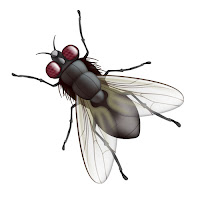The idea of death, the fear of it, haunts the human animal like nothing else. - EB
It's only death; it's not the end of the world, is it? - SH
As a thanatologist, I'm somewhat embarrassed to admit that I still haven't got round to fully reading Ernest Becker's seminal - and Pulitzer Prize winning - text The Denial of Death (1973); a psychological and philosophical examination of how mankind has attempted to deal with (and disguise) the fate that awaits.
All forms of human culture and civilisation, argues Becker, constitute an elaborate defence mechanism against biological reality. That's what we, as symbolic animals, are extremely good at; defiantly creating a world of meaning which allows us to transcend the fact that we end up as worm food or a few pounds of ash.
Becker seems to find this ability heroic, but that's not the term I'd use. For a fantasy of immortality remains just that and, ultimately, no life matters and no great work will be remembered.
In other words, in the grand scheme of things, there is no grand scheme and Becker's privileging of religious illusion in which our animal and mortal nature is given spiritual significance - over what he dismisses as hedonistic pursuits and petty concerns - is just conventional moral prejudice [1].
It's surprising, therefore, that Sebastian Horsley - a man who loved taking drugs and admired those who delighted in their own triviality - should claim that no book, before or since, has had such a powerful effect on him as The Denial of Death.
I'm not sure, however, that Horsley carefully follows the thread of Becker's argument. Does the latter, for example, really want us to admit that we are merely "doomed and defecating creatures"? [2] I don't think so. His project is founded upon man's dual nature as he understands it and wishes to affirm that we are so much more than simply animals that eat, shit, and die.
One can also see from the quotations above, that Becker and Horsley have a radically different attitude towards death; the former's existential anxiety is amusingly negated by the latter's dandyesque insouciance and flippancy.
And, finally, I very much doubt that Becker would endorse Horsley's scatological and masturbatory attempt at terror management:
"I was so affected by [The Denial of Death] that I felt I had to respond. [...] So I locked myself into my own flat, stripped myself naked and sat there listening to Beethoven's Ninth. After a few hours I defecated in a neat pile on the floor and scooped it up in my hands. Running it through my fingers, like a gardener assessing the friability of the soil, I examined it. It was slimy as wet clay.
It would do. I used my shit to swipe the word MAN on my chest, and then PIG on the walls. Then I covered the rest of my body in ordure until no flesh was visible. Beethoven swelled through the room. I sat there musing. Sex, I decided, returning to a favourite subject, was interesting. But not as important as excretion. [...] My philosophical insight gave me a hard on. I had a wank to quieten the imperious urge." [3]
Horsley remains, so he tells us, lying on the floor, eating and sleeping amid his bodily waste, for three whole days, until he finally felt able to crow like a cock on his own dunghill:
"When the whiff got a bit too much - it was high summer - I opened the patio door. I was a little concerned about the neighbours. And slightly worried that my landlords [...] would stage one of their impromptu checks. But I needn't have worried. Even the flies left me alone." [4]
Notes
[1] In an essay on The Denial of Death, Daniel Podgorski comes to a similar conclusion and describes reading Becker's celebrated work as an unexpectedly disappointing experience. For concealed behind "the parade of theorists and the solid analytical prose" is an "old-fashioned, moralizing,
pessimistic set of theses: that humanity is in denial of mortality
because of a 'necessary' denial of the human body and reality; that
humanity can only exorcise the dread of death by embracing blind faith
and rooting out 'aberrant' thoughts and behaviors; and that death can
only be truly faced by those who approach the study of humanity and
society through a (reductive) structuralist lens".
Like Podgorski, I think all three of these notions deserve to be critically examined and that, upon such an examination, they reveal themselves as misguided and false.
Podgorski's essay - 'The Denial of Life:
A Critique of Pessimism, Pathologization, and Structuralism in Ernest Becker's The Denial of Death' - can be found on The Gemsbok (22 Oct 2019): click here.
[2] Sebastian Horsley, Dandy in the Underworld, (Sceptre, 2008), p. 94.
[3] Ibid.
[4] Ibid., pp. 94-95.





.jpg)

.jpg)
.jpg)
.jpg)
.jpg)



.jpg)

